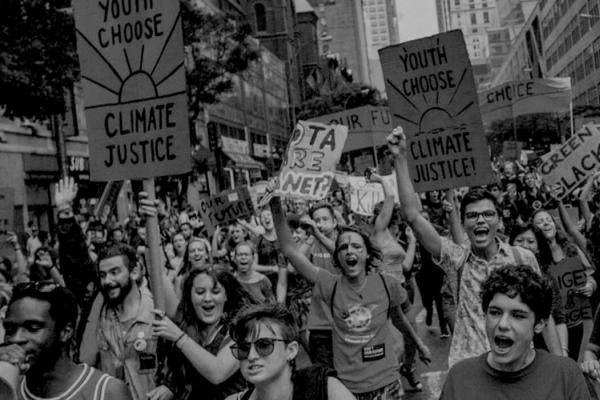IF YOU'RE LOOKING for the climate movement this year, you’ll find it at city councils arguing for 100 percent renewable energy, at pension boards demanding fossil fuel divestment, and in farm fields trying to block pipelines. But you’ll also need to track down a few ramshackle houses in swing states across the country.
Those houses will hold hundreds of young people—at least it will hold them late at night, once they’re done with the long work of knocking on doors, handing out voter guides, and going to rallies. These “movement houses” are the most visible face of the Sunrise Movement, one of those reminders that even the poisonous politics of our moment holds real possibilities.
The young people who founded Sunrise weren’t actually anticipating a Trump victory. “We had had a plan to focus on building popular support for climate change, anticipating that a Democratic president would be pushed to take action on climate if a majority of Americans wanted it and made enough noise,” Varshini Prakash, the group’s engaging spokeswoman who cut her teeth as a highly successful divestment activist at UMass Amherst, said in an interview last summer. But then came that fateful November day, and “our world turned upside-down.” Now it wasn’t about pushing Clinton harder—it was about pushing back against the desperate threat that Trump represented: to the Constitution, to vulnerable people, and to the climate, which can’t wait a decade or two for sanity to return to our national life. “When the dust settled we came to an important realization: We have to figure out how to win elections.”
There’s been an increasing tide of youth electoral organizing in recent years, much of it focused around climate change, a crucial issue for new voters. Tom Steyer’s NextGen America, for instance, poured resources into this effort in the last electoral cycle, and it worked: Clinton didn’t win, but she did very well in the college precincts that Steyer’s troops targeted. As Ben Wessel, who helped lead the NextGen effort, put it: “In millennial-majority precincts, turnout was up and support for Clinton was on par with Obama in 2012.” In other words, don’t blame the kids.
I got to see that work up close, speaking and canvassing with college students across Ohio and Pennsylvania during the waning days of the Clinton campaign. It’s not easy—standing on the quad with a clipboard trying to register young people is a reminder that civic life is in some ways foreign to many of the next generation. They have seen too many disappointing politicians, and been disappointed when the politicians they did trust (Bernie!) were squeezed out.
But whenever they turn out to vote—in last year’s Virginia primaries, for instance—they show the generosity of spirit that marks what we’re now calling the post-millennial generation (Generation Z, if you’re going alphabetically). They’re dramatically open to new ideas and new people, willing to break the stale molds of American politics.
Which is why it’s so sweet to imagine the conversations in those “movement houses” at day’s end, as young people struggle to come to terms with the politics of the present and start creating the politics of the future, one precinct at a time.

Got something to say about what you're reading? We value your feedback!

